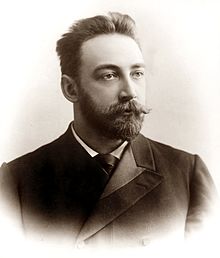Pyotr Lebedev
Pyotr Nikolaevich Lebedev | |
|---|---|
 | |
| Born | 24 February 1866 |
| Died | 1 March 1912 (aged 46) Moscow, Russian Empire |
| Nationality | Russian |
| Alma mater | University of Strasbourg |
| Known for | Demonstration of radiation pressure |
| Scientific career | |
| Fields | Physicist |
| Institutions | Moscow State University |
| Doctoral advisor | August Kundt |
| Doctoral students | P. P. Lazarev |
Pyotr Nikolaevich Lebedev (Russian: Пётр Никола́евич Ле́бедев; 24 February 1866 – 1 March 1912) was a Russian physicist. His name was also transliterated as Peter Lebedew[1] and Peter Lebedev.[2] Lebedev was the creator of the first scientific school in Russia.
Career
[edit]Lebedev made his doctoral degree in Strasbourg under the supervision of August Kundt in 1887–1891. In 1891, he started working in Moscow State University in the group of Alexander Stoletov. There he made his famous experimental studies of electromagnetic waves.
Along with Indian physicist Jagadish Chandra Bose he was one of the first to investigate millimeter waves, generating 50 GHz (6 mm) microwaves beginning in 1895 with a spark oscillator made of two platinum cylinders 1.5 cm long and 0.5 diameter immersed in kerosene at the focus of a parabolic reflector, and detecting the waves with an iron-constantan thermocouple detector.[3]
With this apparatus, he extended the work of Heinrich Hertz to higher frequencies, duplicating classical optics experiments using quasioptical components such as lenses, prisms and quarter-wave plates made of sulfur and wire diffraction gratings to demonstrate refraction, diffraction, double refraction, birefringence and polarization of millimeter waves.
He was the first to measure the pressure of light on a solid body in 1899. The discovery was announced at the World Physics Congress in Paris in 1900,[4] and became the first quantitative confirmation of Maxwell's theory of electromagnetism.[1]
An English translation of the paper as well as a historical review is in.[5]
In 1909, he reported that the pressure of light on gas is in agreement with predictions based on Maxwell's theory.[6][7]
Later life
[edit]In 1901, he became a professor at Moscow State University, however, he quit the University in 1911, protesting against the politics of the Ministry of Education. In the same year, he received an invitation to become a professor in Stockholm, which he rejected. He died the next year of a hereditary heart condition.[6]
Legacy
[edit]The Lebedev Physical Institute in Moscow and the lunar crater Lebedev are named after him.
See also
[edit]References
[edit]- ^ a b Lebedew, P. (1901). "Untersuchungen über die Druckkräfte des Lichtes". Annalen der Physik. 311 (11): 433–458. Bibcode:1901AnP...311..433L. doi:10.1002/andp.19013111102.
- ^ Stavrou, T. G., ed. (1969). Russia Under the Last Tsar. University of Minnesota Press. p. 170. ISBN 978-0816605149.
- ^ A. A. Kostenko, A. I. Nosich, P. F. Goldsmith, "Historical background and development of Soviet quasioptics at near-millimeter and sub-millimeter wavelengths" in Sarkar, T. K.; Mailloux, Robert; Oliner, Arthur A. (2006). History of Wireless. John Wiley and Sons. pp. 478–488. ISBN 0471783013.
- ^ P. Lebedew,“Les forces de Maxwell-Bartoli dues à la pression de la lumière” Rapports présentés au Congrès International de Physique 2, 133 (1900).
- ^ Masalov, Anatoly V. (2019), Boyd, Robert W.; Lukishova, Svetlana G.; Zadkov, Victor N. (eds.), "First Experiments on Measuring Light Pressure I (Pyotr Nikolaevich Lebedev)", Quantum Photonics: Pioneering Advances and Emerging Applications, Cham: Springer International Publishing, pp. 425–453, doi:10.1007/978-3-319-98402-5_12, ISBN 978-3-319-98402-5, retrieved 2024-04-16
- ^ a b Khramov, Yu A (1986-12-31). "Petr Nikolaevich Lebedev and his school (On the 120th anniversary of the year of his birth)". Soviet Physics Uspekhi. 29 (12): 1127–1134. doi:10.1070/PU1986v029n12ABEH003609. ISSN 0038-5670.
- ^ Lebedew, Peter (1910-06-01). "The Pressure of Light on Gases". The Astrophysical Journal. 31: 385. doi:10.1086/141769. ISSN 0004-637X.
